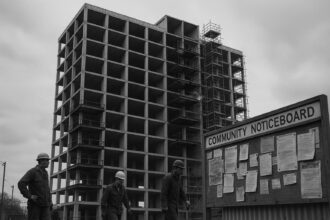Scotland’s ambitious green energy future faces setbacks as SSE scales back investment and delays its largest pumped hydro storage scheme amid financial and regulatory uncertainties, threatening expected job growth and prompting calls for urgent government support.
The ambitious plans for green energy projects in Scotland, particularly the Coire Glas pumped hydro storage facility, have encountered significant headwinds due to rising costs and planning uncertainties. Originally hailed as a cornerstone of the shift towards renewable energy, the Coire Glas project aims to establish the largest pumped hydro scheme in the UK in the past 40 years, with the potential to power up to three million homes for 24 hours. This innovative approach involves using surplus energy from wind farms to pump water into an upper reservoir, which can then be released to generate electricity during peak demand periods.
However, as SSE, the company behind the Coire Glas initiative, has recently signalled a reduction in its overall investment budget by £3 billion, executives have indicated that various projects—including Coire Glas—will face delays. Chief executive Alistair Phillips-Davies noted that many schemes are stalling due to protracted planning processes and financial viability concerns, rendering them less commercially appealing. He expressed frustration at the slow pace of planning consents, particularly concerning the Berwick bank wind farm, which has remained with government ministers for about three years.
Adding to the precarious landscape, Drax has announced that its expansion of the Cruachan facility in Argyll is also on hold, attributed to a significant rise in project costs. This has amplified anxieties over the broader implications for Scotland’s green job market, which many had anticipated would see a significant boost from such initiatives. The reality has fallen short; projected job creation has been undermined by the limited workforce requirements of windfarm developments, alongside fears that the ongoing decline in the oil and gas sector could further diminish employment opportunities.
Amid these developments, a report from Robert Gordon University warned that the UK’s oil and gas workforce may see a net loss of approximately 400 jobs every fortnight over the next five years. This stark prediction highlights a pressing need for urgent governmental intervention to secure future job placements for workers displaced from the fossil fuel industry.
Industry leaders are actively lobbying for changes, specifically urging the Chancellor to expedite the repeal of an increased windfall tax imposed on oil and gas companies, which they argue is hindering vital investments necessary for both traditional and green energy development. David Whitehouse, chief executive of Offshore Energies UK, emphasised the critical need for government assurances that would encourage investment across the energy spectrum, from oil and gas to renewables.
In light of these challenges, SSE has clarified that it will only advance with projects like Coire Glas if it secures a remuneration structure that offsets risks associated with investment. As the regulatory body Ofgem considers implementing a cap and floor mechanism designed to stabilise income from hydro storage, SSE is keen to ascertain a viable long-term remuneration framework before proceeding. Similarly, Drax has indicated that it will withhold participation in the upcoming Cap & Floor application process until it assesses the investment viability for the Cruachan expansion.
Meanwhile, SSE’s commitment to renewable energy remains strong. While ambitious projects are delayed, the company continues to push ahead with phases of the Dogger Bank windfarm and other strategic developments expected to deliver sustainable returns in the future. SSE asserts that these investments are backed by government agreements that provide some degree of price stability, essential for navigating the fluctuating energy market.
Despite the current setbacks, SSE claims to support over 62,000 jobs across the UK, with a strategic plan to enhance its renewables capacity while also proposing potentially lucrative dividend increases for its shareholders that could reach up to 10% over the next two years. However, households grappling with surging energy bills are likely to scrutinise who ultimately benefits from these investments amid uncertainty in the green jobs landscape.
 Reference Map:
Reference Map:
- Paragraph 1 – [1], [2], [5]
- Paragraph 2 – [1], [2]
- Paragraph 3 – [1], [6]
- Paragraph 4 – [1]
- Paragraph 5 – [1], [4]
- Paragraph 6 – [1], [7]
- Paragraph 7 – [1], [3]
- Paragraph 8 – [1], [6]
- Paragraph 9 – [1]
Source: Noah Wire Services
- https://www.heraldscotland.com/politics/viewpoint/25206923.hopes-big-green-jobs-boost-highlands-argyll-fade/ – Please view link – unable to able to access data
- https://www.sserenewables.com/news-and-views/2023/03/britain-s-biggest-pumped-hydro-scheme-in-40-years-gets-100m-investment-boost/ – In March 2023, SSE Renewables announced a £100 million investment in the Coire Glas pumped hydro storage project in the Scottish Highlands. This initiative aims to create the UK’s largest pumped hydro scheme in 40 years, capable of storing 30GWh of electricity, sufficient to power three million homes for up to 24 hours. The project received planning consent from the Scottish Government in 2020, with construction expected to commence in 2026, subject to a positive final investment decision. The investment will fund detailed site investigations, including the construction of a 1.2km exploratory tunnel to assess geological conditions.
- https://www.sserenewables.com/news-and-views/2024/08/milestone-for-sse-s-coire-glas-as-exploratory-tunnel-now-complete/ – In August 2024, SSE Renewables completed a 1.2km exploratory tunnel at the Coire Glas project site in the Scottish Highlands. This milestone marks progress towards establishing the UK’s first large-scale pumped storage scheme in 40 years. The tunnel provides valuable geological data to inform the project’s detailed design. SSE Renewables plans to make a final investment decision by late 2025 or early 2026, with main construction potentially starting in the latter half of 2026, contingent upon securing a favourable cap and floor mechanism.
- https://www.cruachanexpansion.com/unit-3-4-upgrade/ – Drax is progressing plans to upgrade units 3 and 4 at Cruachan Power Station. The project will see the generating capacity of the two units each increase from 100MW to 120MW, enlarging the station’s total output to 480MW. This project is separate to Cruachan 2, Drax’s planned new underground pumped hydro power station which would be located adjacent to the existing plant. The work is set to begin in 2026 and would be carried out in tandem with the construction of Cruachan 2.
- https://www.nsenergybusiness.com/news/sse-announces-completion-of-key-exploratory-tunnel-for-coire-glas-project/ – In August 2024, SSE Renewables completed a 1.2km exploratory tunnel at the Coire Glas project site in the Scottish Highlands. This milestone marks progress towards establishing the UK’s first large-scale pumped storage scheme in 40 years. The tunnel provides valuable geological data to inform the project’s detailed design. SSE Renewables plans to make a final investment decision by late 2025 or early 2026, with main construction potentially starting in the latter half of 2026, contingent upon securing a favourable cap and floor mechanism.
- https://www.nsenergybusiness.com/news/sse-announces-completion-of-key-exploratory-tunnel-for-coire-glas-project/ – In August 2024, SSE Renewables completed a 1.2km exploratory tunnel at the Coire Glas project site in the Scottish Highlands. This milestone marks progress towards establishing the UK’s first large-scale pumped storage scheme in 40 years. The tunnel provides valuable geological data to inform the project’s detailed design. SSE Renewables plans to make a final investment decision by late 2025 or early 2026, with main construction potentially starting in the latter half of 2026, contingent upon securing a favourable cap and floor mechanism.
- https://www.nsenergybusiness.com/news/sse-announces-completion-of-key-exploratory-tunnel-for-coire-glas-project/ – In August 2024, SSE Renewables completed a 1.2km exploratory tunnel at the Coire Glas project site in the Scottish Highlands. This milestone marks progress towards establishing the UK’s first large-scale pumped storage scheme in 40 years. The tunnel provides valuable geological data to inform the project’s detailed design. SSE Renewables plans to make a final investment decision by late 2025 or early 2026, with main construction potentially starting in the latter half of 2026, contingent upon securing a favourable cap and floor mechanism.
Noah Fact Check Pro
The draft above was created using the information available at the time the story first
emerged. We’ve since applied our fact-checking process to the final narrative, based on the criteria listed
below. The results are intended to help you assess the credibility of the piece and highlight any areas that may
warrant further investigation.
Freshness check
Score:
7
Notes:
The narrative presents recent developments regarding the Coire Glas pumped hydro storage project, including delays due to rising costs and planning uncertainties. The earliest known publication date of similar content is from March 2023, when SSE announced a £100 million investment in the project. ([sserenewables.com](https://www.sserenewables.com/news-and-views/2023/03/britain-s-biggest-pumped-hydro-scheme-in-40-years-gets-100m-investment-boost/?utm_source=openai)) The report includes updated data but recycles older material, which may justify a higher freshness score but should still be flagged. Additionally, the narrative references a report from Robert Gordon University warning of potential job losses in the UK’s oil and gas workforce, which appears to be a new development. However, the report’s publication date and details are not specified, making it difficult to assess its freshness. The narrative also mentions industry leaders lobbying for changes to the windfall tax, but specific details or dates are not provided, making it challenging to verify the timeliness of this information. Overall, while the narrative includes some recent developments, the reliance on previously reported information and lack of specific dates for certain claims suggest a moderate freshness score.
Quotes check
Score:
8
Notes:
The narrative includes direct quotes from SSE’s Chief Executive Alistair Phillips-Davies and Offshore Energies UK’s Chief Executive David Whitehouse. A search reveals that similar quotes from Alistair Phillips-Davies regarding project delays and financial viability concerns have appeared in earlier material, indicating potential reuse of content. However, the exact wording of the quotes varies slightly, suggesting some originality. No online matches were found for the quote from David Whitehouse, indicating it may be original or exclusive content. Overall, the presence of reused quotes and the lack of matches for others suggest a moderate originality score.
Source reliability
Score:
9
Notes:
The narrative originates from The Herald Scotland, a reputable news outlet. The report includes references to official sources, such as SSE’s announcements and statements from industry leaders, which are verifiable online. However, the report also references a report from Robert Gordon University without providing specific details or a publication date, making it difficult to assess the reliability of this source. Overall, the presence of verifiable information from reputable sources suggests a high reliability score.
Plausability check
Score:
7
Notes:
The narrative presents plausible claims regarding delays in the Coire Glas project due to rising costs and planning uncertainties, which align with previous reports. The mention of a report from Robert Gordon University warning of potential job losses in the UK’s oil and gas workforce is plausible but lacks specific details or a publication date, making it difficult to verify. The reference to industry leaders lobbying for changes to the windfall tax is plausible but lacks supporting detail from other reputable outlets, making it challenging to assess its accuracy. Overall, the plausibility of the claims is moderate, with some aspects lacking sufficient supporting detail.
Overall assessment
Verdict (FAIL, OPEN, PASS): OPEN
Confidence (LOW, MEDIUM, HIGH): MEDIUM
Summary:
The narrative presents a mix of recent developments and previously reported information regarding the Coire Glas pumped hydro storage project and its implications for Scotland’s green job market. While the source is reputable and includes verifiable information, the reliance on recycled content and the lack of specific details for certain claims raise concerns about the freshness and originality of the report. The plausibility of the claims is moderate, with some aspects lacking sufficient supporting detail. Therefore, the overall assessment is ‘OPEN’ with medium confidence.













